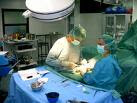Two Major Hospitals Now Recommend Music with Surgery
In the past two months, both the Mayo Clinic in Minnesota and the Cleveland Clinic in Ohio have come out advocating music! The Mayo Clinic said:
“Research on the effectiveness of music therapy dates back to the 1920s, when a study reported individuals’ blood pressure dropped when listening to music. Currently, our program is conducting a research study to measure the effects of music therapy on pain, anxiety and tension. As part of the Cardiovascular Surgery Healing Enhancement Program, rooms for cardiac surgery patients have music systems. A selection of CD music is available at each cardiac surgical unit. “
The Cleveland Clinic said:
“Research on music and the brain has shown that it can reduce stress, alleviate pain and promote relaxation. And new research from the Cleveland Clinic shows that music can even reach into deep brain structures unrelated to hearing and memory to literally soothe nerves.
Patients receiving deep-brain-stimulation surgery for Parkinson’s disease, essential tremor and several other conditions have to be awake for much of the surgery to tell surgeons if their symptoms improve when electrodes are placed deep in their brains.
All of this is very exciting news to me as I am hoping to make my surgical headphones standard in hospitals around the world. Right now I am selling them online at http://www.surgicalheadphones.com/, but I hope eventually to sell them to hospitals so that they can give them to all surgical patients. Stay tuned! The big launch will be in 2010!





